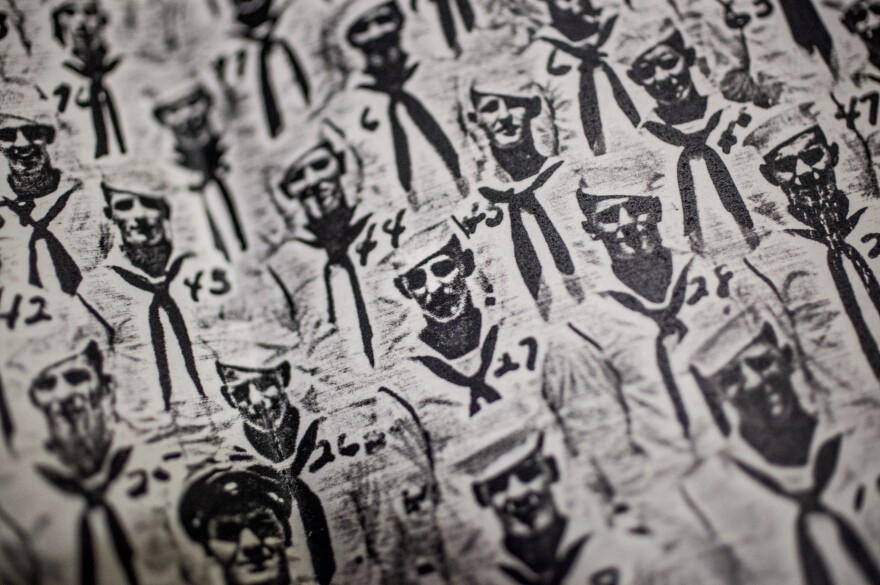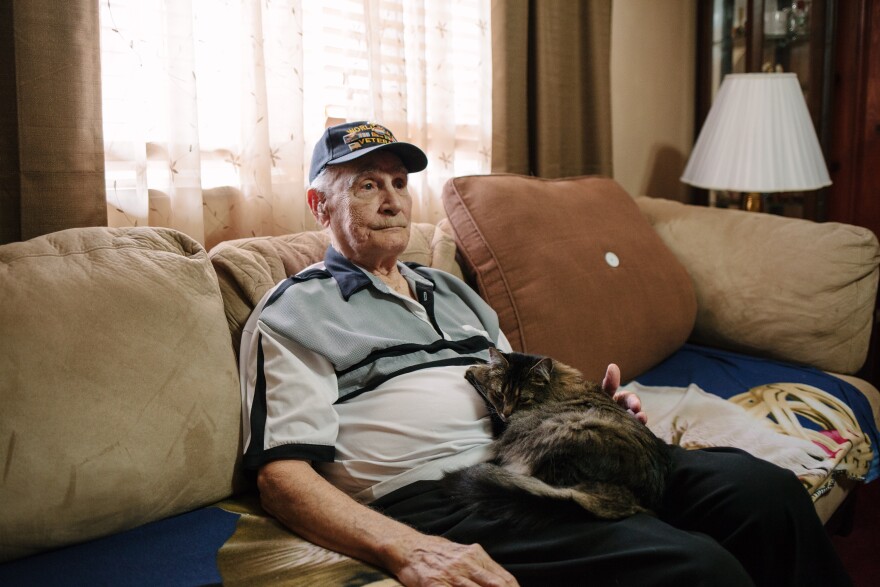In secret chemical weapons experiments conducted during World War II, the U.S. military exposed thousands of American troops to mustard gas.
When those experiments were formally declassified in the 1990s, the Department of Veterans Affairs made two promises: to locate about 4,000 men who were used in the most extreme tests, and to compensate those who had permanent injuries.
But the VA didn't uphold those promises, an NPR investigation has found.
NPR interviewed more than 40 living test subjects and family members, and they describe an unending cycle of appeals and denials as they struggled to get government benefits for mustard gas exposure. Some gave up out of frustration.
In more than 20 years, the VA attempted to reach just 610 of the men, with a single letter sent in the mail. Brad Flohr, a VA senior adviser for benefits, says the agency couldn't find the rest, because military records of the experiments were incomplete.
"There was no identifying information," he says. "No Social Security numbers, no addresses, no ... way of identifying them. Although, we tried."
Yet in just two months, an NPR research librarian located more than 1,200 of them, using the VA's own list of test subjects and public records.
The mustard gas experiments were conducted at a time when American intelligence showed that enemy gas attacks were imminent. The tests evaluated protective equipment like gas masks and suits. They also compared the relative sensitivity of soldiers, including tests designed to look for racial difference.
The test subjects who are still alive are now in their 80s and 90s. Each year more of their stories die with them.
"We weren't told what it was," says Charlie Cavell, who was 19 when he volunteered for the program in exchange for two weeks' vacation. "Until we actually got into the process of being in that room and realized, wait a minute, we can't get out of here."
Cavell and 11 other volunteers were locked inside a gas chamber with mustard gas piping inside. Blocks of ice sat on shelves overhead with fans blowing across them to increase the humidity in the room, which intensified mustard gas's effects on the body. After an hour, the officer released six of the men back to their barracks. Cavell and five others were told to stay put.

Inside the chamber, Cavell's skin started to turn red and burn in the places where he sweat the most: between his legs, behind his neck and under his arms. Blisters that eventually increased to the size of half dollar coins started to grow in the same places. At the end of the second hour, the officer ordered Cavell back to his barracks and to continue wearing his gas-saturated uniform.
Cavell, now 88 years old, says the officer threatened him and the other test subjects: If they told anyone about their knowledge or participation in the experiments, they would receive a dishonorable discharge and be sent to military prison at Fort Leavenworth, Kan.
"They put the fear of God in just a bunch of young kids," he says.
These experiments with mustard gas were conducted by the Army and Navy at more than a dozen locations. Some test subjects had only partial exposure, such as having the chemical agents applied directly onto their skin. Others were locked in gas chambers, like Cavell. A third type of test exposed troops to gas outdoors in simulated combat settings.
In all, roughly 60,000 World War II veterans were used as test subjects, and they kept the experiments secret for half a century. A group of them, led by Nat Schnurman, went public with their stories in 1990.
Schnurman, who died in 2013 when he was 87, had suffered debilitating injuries after being tested at the U.S. Naval Training Center in Bainbridge, Md. He filed a federal lawsuit for compensation in 1979, but was unsuccessful because of a legal doctrine that protects the military from being sued for service-related injuries. Schnurman and his wife, Joy, spent the next two decades compiling evidence of the testing in order to put pressure on the military.

When the story broke, VA Deputy Secretary Anthony Principi appeared on 60 Minutes, in 1991, to explain how the agency would respond to men who were injured in the tests: "They should be praised for what they did," Principi said on the CBS News program. "And as far as the secretary and I are concerned, we're about to do right by them."
More than 20 years later, the VA has attempted to contact fewer than a quarter of the thousands it said it would.
One of the men who never heard from the VA was John Berzellini. His wife, Irene, remembers how the experiments affected his health for the rest of his life.
"I remember him laying up in the bedroom up there," she says.
Berzellini says every winter her husband spent weeks in bed with chronic bronchitis — an illness government studies have linked to mustard gas exposure. She says they didn't know that he was eligible for disability benefits when he died of a heart attack in 1995.
In the early 1990s, VA officials also announced the agency would lower its burden of proof to make getting benefits easier in these cases. The process typically relies on evidence, but most of the men in these experiments have none because the tests were done in secret.
"This is not an easy, not a simple thing," Flohr says. "But we have done everything that we could do, I definitely believe that."
The VA created a list of illnesses that are linked to mustard gas exposure — such as skin cancer, leukemia and chronic breathing problems. According to the agency, if a veteran has an illness on the list and can prove he was exposed, he receives benefits.

But NPR interviewed veterans who met both of those requirements and have still been denied for years — sometimes decades — as the VA continues to request more information and proof.
Cavell says that even today, when he comes to a locked door he's reminded of the inside of a gas chamber.
"There was no handle on the door. You couldn't get out," he says. "And that's what I have problems with today. If I go to a locked door, I panic sometimes to try to get out."
In 1988, Cavell requested copies of his records from the experiments he was in at the Naval Research Laboratory. Researchers there had recorded his full name in neat handwriting on lined paper. They had detailed the length of time he spent inside a gas chamber and the level of mustard gas in the air.
Cavell then submitted the documents to the VA as proof of his exposure. He filed claims for several illnesses on the VA's list of those linked to mustard gas, including skin cancer and chronic breathing problems. But until NPR inquired about his case, all of those claims had been denied.
After NPR's inquiry, the VA told NPR there was enough evidence to grant his claims. They based that conclusion on the same information that had been sitting in his VA file for decades. Officials say they can't explain why the benefits weren't granted sooner. Cavell is currently being re-evaluated before the benefits can be disbursed.

Former CIA Director Porter Goss says the VA has mishandled these claims. Goss was a Florida congressman when he was contacted by a group of constituents who were used as test subjects and spoke out on their behalf. "This should have been ancient history by now," he told NPR. "And these people should have long been appropriately provided for."
Goss says he thinks the VA never delivered on its promises because this issue has been disappearing on its own for years. About 500 World War II veterans die each day, according to data maintained by the VA. "I do think there is a little bit of that attitude of: 'This is today's problem, it will be gone by tomorrow,' " Goss says. "But this is a bargain we made. And this goes to the essence of 'Can you trust your government?' And in this case I'm afraid the answer is not yet."
Flohr tells NPR his agency has followed federal statutes in its handling of claims for mustard gas exposure. But Goss says that excuse is at the core of all that is dysfunctional in Washington bureaucracies. "I don't think there's an explanation for why this program wasn't more successful," Goss says. "If I were back in Congress, I'd be asking that question."
Congress has intervened in similar situations. It passed the Agent Orange Act in 1991, which requires the VA to assume that all veterans who served in and around Vietnam were exposed to the chemical. And in 2010, the VA announced it would review 90,000 previously denied Agent Orange claims. To date, these policies have not been applied to World War II vets who were exposed to mustard gas.
Officials at the Pentagon tell NPR it's likely that some of the records about military mustard gas experiments were never recovered. And yet Flohr insists the VA still needs proof in order to grant claims.
"I'm sorry," Flohr says. "But the only thing we can do is follow our statutes and regulations."
Those regulations have kept veterans like Harry Bollinger, 88, from receiving benefits. Bollinger still has chronic breathing problems and breaks out in eczema in places where he was burned as a young Navy recruit:
"Around my privates and under my arms and face and everywhere else," he says.
Bollinger gave up appealing VA rejections in 1994, after four years of traveling back and forth 30 miles to a VA office office in Pittsburgh. Then, in 1996, Bollinger received a military commendation in the mail. The document acknowledges his participation in mustard gas experiments. But Bollinger says he wouldn't go back to the agency after the way he was treated there.

"I was disgusted already. What's the use?" he says.
A tattered ball cap that says World War II veteran hangs by the front door in his house. He says he is proud of his service, and he wears the cap everywhere he goes. But Bollinger says that time in his life is tainted: by the pain he felt as a human test subject in military experiments, and by the VA that told him it wasn't real.
"That's going to be on my tombstone," Bollinger says. "U.S. Navy, Guinea Pig. That won't be too long now probably."
NPR Investigations Research Librarian Barbara Van Woerkom contributed reporting and research to this investigation. NPR Photo Editor Ariel Zambelich and reporters Christopher Groskopf, Jani Actman and Lydia Emmanouilidou also contributed to this story.
Copyright 2023 NPR. To see more, visit https://www.npr.org.



